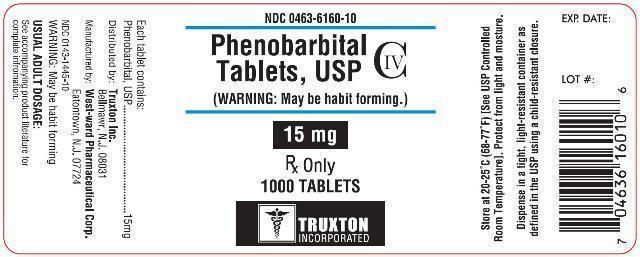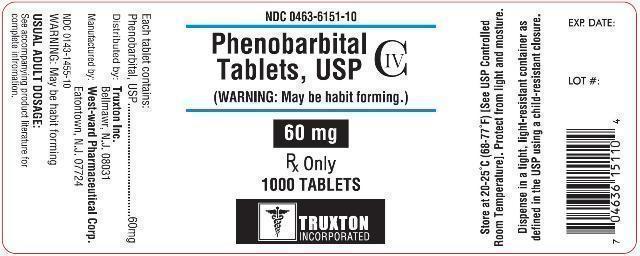DESCRIPTION
Phenobarbital is a barbituric acid derivative for oral administration and occurs as a white, odorless, slightly bitter powder that is soluble in chloroform, freely soluble in alcohol or ether, and slightly soluble in water. Its saturated solution has a pH of about 5.6. Chemically, it is 5-ethyl-5-phenylbarbituric acid with the molecular formula C12H12N2O3 (232.24). The structural formula is as follows:

Each Phenobarbital Tablet, USP contains 15 mg, 30 mg, 60 mg or 100 mg of phenobarbital, USP. Inactive ingredients are as follows:
15 mg, 30 and 60 mg: Calcium Stearate, Colloidal Silicon Dioxide, Corn Starch, and Microcrystalline Cellulose.
100 mg: Anhydrous Lactose, Colloidal Silicon Dioxide, Corn Starch, Docusate Sodium, Lactose Monohydrate, Magnesium Stearate, Microcrystalline Cellulose, and Sodium Starch Glycolate.
CLINICAL PHARMACOLOGY
Phenobarbital, a long-acting barbiturate, is a central nervous system depressant. In ordinary doses, the drug acts as a sedative and anticonvulsant. Its onset of action occurs within 30 minutes, and the duration of action ranges from 5 to 6 hours. It is detoxified in the liver.
INDICATION AND USAGE
Phenobarbital Tablets, USP are indicated for use as a sedative or anticonvulsant.
CONTRAINDICATIONS
Phenobarbital is contraindicated in patients who are hypersensitive to barbiturates. In such patients, severe hepatic damage can occur from ordinary doses and is usually associated with dermatitis and involvement of parenchymatous organs. A personal or familial history of acute intermittent porphyria represents one of the few absolute contraindications to the use of barbiturates. Phenobarbital is also contraindicated in patients with marked impairment of liver function, or respiratory disease in which dyspnea or obstruction is evident. It should not be administered to persons with known previous addiction to the sedative/hypnotic group, since ordinary doses may be ineffectual and may contribute to further addiction.
WARNINGS
In small doses, the barbiturates may increase the reaction to painful stimuli. Taken by themselves, the barbiturates cannot be relied upon to relieve pain or even to produce sedation or sleep in the presence of severe pain.
PRECAUTIONS
General Precautions:
Barbiturates induce liver microsomal enzyme activity. This accelerates the biotransformation of various drugs and is probably part of the mechanism of the tolerance encountered with barbiturates. Phenobarbital, therefore, should be used with caution in patients with decreased liver function. This drug should also be administered cautiously to patients with a history of drug dependence or abuse(see DRUG ABUSE AND DEPENDENCE ).
Phenobarbital may decrease the potency of coumarin anticoagulants; therefore, patients receiving such concomitant therapy should have more frequent prothrombin determinations. As with other sedatives and hypnotics, elderly or debilitated patients may react to barbiturates with marked excitement, depression, or confusion.
The systemic effects of exogenous hydrocortisone and endogenous hydrocortisone (cortisol) may be diminished by phenobarbital. Thus, this product should be administered with caution to patients with borderline hypoadrenal function, regardless of whether it is of pituitary or of primary adrenal origin.
Information for Patients:
Phenobarbital may impair the mental and/or physical abilities required for the performance of potentially hazardous tasks, such as driving a car or operating machinery. The patient should be cautioned accordingly.
Drug Interactions:
Phenobarbital in combination with alcohol, tranquilizers, and other central nervous system depressants has additive depressant effects, and the patients should be so advised. Patients taking this drug should be warned not to exceed the dosage recommended by their physician. Toxic effects and fatalities have occurred following overdoses of phenobarbital alone and in combination with other central nervous system depressants. Caution should be exercised in prescribing unnecessarily large amounts of phenobarbital for patients who have a history of emotional disturbances or suicidal ideation or who have misused alcohol and other CNS drugs (see OVERDOSAGE).
Usage in Pregnancy:
Pregnancy Category B – Reproduction studies have been performed in animals and have revealed no evidence of impaired fertility or harm to the fetus due to phenobarbital. There are, however, no adequate and well-controlled studies in pregnant women. Because animal reproduction studies are not always predictive of human response, this drug should be used during pregnancy only if clearly needed.
ADVERSE REACTIONS
The following adverse reactions have been reported:
CNS Depression:
Residual sedation or “hangover”, drowsiness, lethargy, and vertigo. Emotional disturbances and phobias may be accentuated. In some persons, barbiturates such as phenobarbital repeatedly produce excitement rather than depression, and the patient may appear to be inebriated. Like other nonanalgesic hypnotic drugs, barbiturates, such as phenobarbital, when given in the presence of pain, may cause restlessness, excitement, and even delirium. Rarely, the use of barbiturates results in localized or diffused myalgic, neuralgic, or arthritic pain, especially in psychoneurotic patients with insomnia. The pain may appear in paroxysms, is most intense in the early morning hours, and is mot frequently located in the region of the neck, should girdle, and upper limbs. Symptoms may last for days after the drug is discontinued.
Allergic:
Acquired hypersensitivity to barbiturates consists chiefly in allergic reactions that occur especially in persons who tend to have asthma, urticaria, angioedema, and similar conditions. Hypersensitivity reactions in this category include localized swelling, particularly of the eyelids, cheeks, or lips, and erythematous dermatitis. Rarely, exfoliative dermatitis (e.g., Stevens-Johnson syndrome and toxic epidermal necrolysis) may be caused by phenobarbital and can prove fatal. The skin eruption may be associated with fever, delirium, and marked degenerative changes in the liver and other parenchymatous organs. In a few cases, megaloblastic anemia has been associated with the chronic use of phenobarbital.
DRUG ABUSE AND DEPENDENCE
Controlled Substance – Phenobarbital is a Schedule IV drug.
Dependence:
Prolonged, uninterrupted use of barbiturates (particularly the short-acting drugs), even in therapeutic doses, may result in psychic and physical dependence. Withdrawal symptoms due to physical dependence following chronic use of large doses of barbiturates may include delirium, convulsions, and death.
OVERDOSAGE
The signs and symptoms of barbiturate poisoning are referable especially to the central nervous system and the cardiovascular system. Moderate intoxication resembles alcoholic inebriation. In severe intoxication, the patient is comatose, the level of reflex activity conforming in a general way to the intensity of the central depression. The deep reflexes may persist for some time despite coexistent coma. The Babinski sign is often positive. The EEG may be of the “burst-suppression” type, with brief periods of electrical silence. The pupils may be constricted and react to light, but late in the courage of barbiturate poisoning they may show hypoxic paralytic dilatation. Respiration is affected early. Breathing may be either slow or rapid and shallow; Cheyne-Stokes rhythm may be present. Respiratory minute volume is diminished, and hypoxia and respiratory acidosis may develop. The blood pressure falls, owing partly to depression of medullary vasomotor centers; partly to a direct action of the drug on the myocardium, sympathetic ganglia, and vascular smooth muscle; partly to hypoxia.
The patient thus develops a typical shock syndrome, with a weak and rapid pulse, cold and clammy skin, and a rise in the hematocrit. Respiratory complications (atelectasis, pulmonary edema, and bronchopneumonia) and renal failure are much dreaded and not infrequent concomitant of severe barbiturate poisoning. There is usually hypothermia, sometimes with temperatures as low as 32°C.
Treatment:
General management should consist of symptomatic and supportive therapy, including gastric lavage, administration of intravenous fluids, and maintenance of blood pressure, body temperature and adequate respiratory exchange. Dialysis will increase the rate of removal of barbiturates from the body fluids. Antibiotics may be required to control pulmonary complications.
DOSAGE AND ADMINISTRATION
Oral Sedative Dose, Adults – 30 to 120 mg daily in 2 or 3 divided doses. Children – 6 mg/kg of body weight daily in 3 divided doses.
Oral Hypnotic Dose, Adults – 100 to 320 mg.
Oral Anticonvulsant Dose, Adults – 50 to 100 mg 2 or 3 times daily.
Children – 15 to 50 mg 2 or 3 times daily.
HOW SUPPLIED
Phenobarbital Tablets, USP 15 mg: White, Round Tablet; Debossed “West-ward 445” on one side and plain on the other side.
Bottles of 100 and 1000 tablets
Phenobarbital Tablets, USP 30 mg: White, Round, Scored Tablet; Debossed “West-ward 450” on one side and Scored on the other side.
Bottles of 100 and 1000 tablets
Phenobarbital Tablets, USP 60 mg: White, Round Tablet; Debossed “WW 455” on one side and plain on the other side.
Bottles of 100 and 1000 tablets
Phenobarbital Tablets, USP 100 mg: White, Round, Scored Tablet; Debossed “WW 458” on one side and Scored on the other side.
Bottles of 100 and 1000 tablets
Store at 20-25°C (68-77°F) [See USP Controlled Room Temperature]. Protect from light and moisture.
Dispense in a tight, light-resistant container as defined in the USP using a child-resistant closure.
Manufactured by:
West-ward Pharmaceutical Corp.
Eatontown, NJ 07724
Revised March 2012



